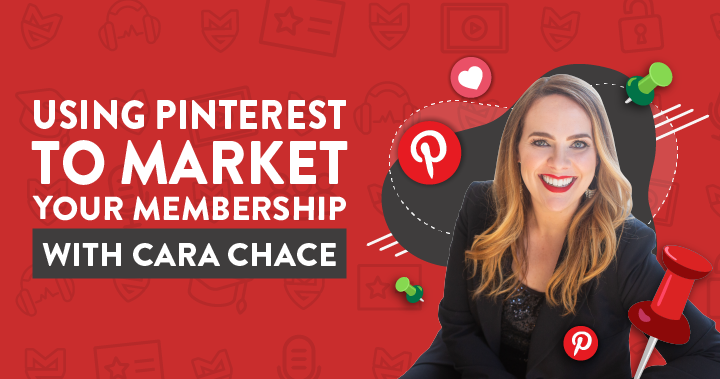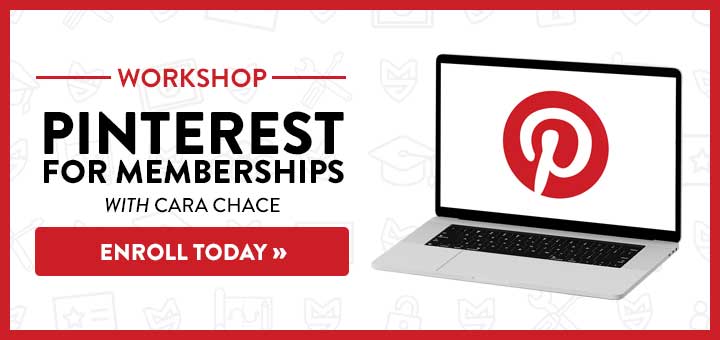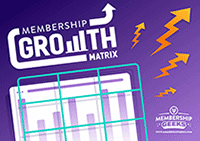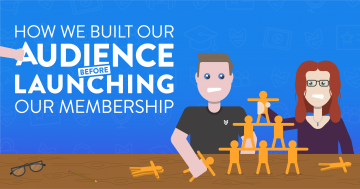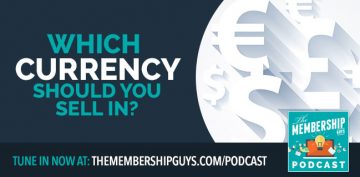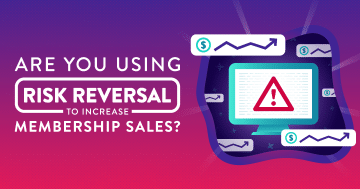Usually when I interview somebody about marketing memberships, I’ve already got a solid level of understanding on the topic… Not this time.
Pinterest is one of those platforms that I know about, sometimes use, and post to without much of a strategy. I know it’s not good practice but, look, I never claimed to be perfect!
When I had the chance to speak to leading Pinterest marketing expert Cara Chace, I felt like I was back at school. I was taking notes so fast I thought the paper was going to catch fire!
The great thing about Cara is that she runs her own membership as well as her marketing agency, so she has actionable, tried-and-tested advice about marketing memberships on Pinterest.
I was blown away by some of the stats Cara shared with me: 5-year old content that’s still going viral, 20¢ email sign-ups, and 150-200% ROI on ads.
The potential for memberships on Pinterest is astonishing – and it’s probably got the best performance for organic content out of any platform.
If you want to know how Pinterest can help you reach more people and get more members, you need to hear Cara’s advice!
The basics of Pinterest
Before we get into the details of Pinterest marketing, it’s probably a good idea to explain some of the simpler elements of the platform.
I’m not ashamed to admit that I didn’t know some of this, so I hope it’ll prove useful for you too.
With over 300 million users, 29% user growth from 2019 to 2020, and 12% increase in potential ad reach between Q3 and Q4 2019, Pinterest is a huge platform that many businesses are massively underutilizing!
So, what is this hidden gem of a platform all about?
- At its core, Pinterest functions on keywords so, although it gets lumped in with social media platforms, it’s really more of a search engine
- ‘Pins’ are images or videos that link through to websites – it’s a visual medium
- ‘Boards’ are the way you organise pins – think of them as folders that categorize your content
- Engagement is different on Pinterest compared to social media, the main metrics are ‘repins’ and click-throughs
- It isn’t all weddings, recipes and hairstyles – infographics, walk-throughs, and quotes are all popular and effective
- Pinterest users generally want to learn, research, or feel inspired
There’s lots more to say about Pinterest, but those are the basics. It’s a visual search engine that encourages users to visit other websites – definitely not social media then!
Pinterest best practice
Okay, we’ve got a basic understanding of Pinterest, now we can talk about how to actually use this amazing and underutilized platform.
Some key things to know about using Pinterest properly:
- Pins use a vertical 2:3 image ratio, and the same with video
- Make sure your pins are properly branded and easily identifiable as yours
- Pinterest reads the writing on images as well as the description, so ensure there is cohesion between your graphic, title, description, and the URL of the webpage connected to your pin
- You need to be consistent – so spread your pins out across days and weeks, rather than pinning 50 on the same board in one day and then never touching it again
- Recency doesn’t matter – Cara’s best-performing pin is a blog post from 2015!
- Repin content from other users that will help your ideal customer. Think about what else your ideal customer is looking for (e.g. not just membership content but email marketing, copywriting, and web design content) and repin that content
- Make use of boards – they are indexed by Google, attach important metadata to pins, and make your content easier to access. The best comparison I can make is that it’s like having a clear and easy-to-navigate sitemap for your website
What to avoid doing on Pinterest
Just as there is Pinterest best practice, there are also some things to avoid doing on the platform, such as:
- Using templates from design sites without making them your own – it’s very obvious when someone has put little effort into a Canva template!
- Sharing nice-looking pins that aren’t going to convert. A picture of a sunset might look good, but if it isn’t set up to drive traffic to your website, it’s not going to work for your business. Clicks are more valuable than repins, from a business perspective
- Putting links in pin descriptions or using cloaked/shortened links are sure-fire spam signals to Pinterest
- Pinning the same images. You can have as many pins as you want pointing to the same URL, but they need to be different. Changing descriptions, images, and titles is essential
- Not knowing your keywords – this is how Pinterest functions! Do keyword research on Pinterest specifically, not just using a list you got from Google when you launched
- Lacking consistency – you can’t just use Pinterest as a dumping ground, you need to post regularly
- Focusing too heavily on video. They don’t function the same as image pins yet and, as a result, can get really high impressions but very low clicks
Advertising on Pinterest
Pinterest does have an advertising platform attached to it, but Cara was eager to stress that it’s not quite as in-depth or nimble as Facebook’s, for example. That doesn’t seem to be a problem, though, as Cara shared some genuinely unbelievable stats about ad performance on Pinterest:
- Cara has achieved email sign-ups for an ad spend of as little as 20¢
- 150%-200% ROI (in Cara’s words, it’s “like nothing I have ever seen before!”)
- For every $1 spent, $4 in gross returns and $2 profit
Advertising on Pinterest is done through ‘promoted pins’.
A key difference here between Pinterest ads and, say, Facebook ads, is that you can only promote a pin that already exists. Your advertising campaigns don’t exist in a vacuum like they do on Facebook.
In essence, promoted pins work the way boosting a Facebook post should.
And this is a great thing!
If one of your pins picks up traction, you can promote it and let it snowball further and faster.
Once you take the ad spend away, that pin will still exist and continue to generate you traffic.
It doesn’t disappear.
Pinterest doesn’t offer quite the same level of in-depth targeting as Facebook, but you can set custom audiences, target by keywords/demographics/interests, and there is also something called Pinterest Tag that operates in exactly the same way as Facebook Pixel.
It’s also worth noting that Pinterest is not quite as nimble with its algorithm as Facebook.
While Facebook moves quickly, Pinterest requires more of a long-term, evergreen strategy.
If you are launching a product in a few weeks, use Facebook.
If you want to build your email list consistently and get good ROI on your ad spend, Cara recommends running ads on Pinterest with a spend of $5-$10 per day.
In her experience (and, of course, there is no guarantee) this can achieve that 150% – 200% ROI.
How to create your Pinterest marketing strategy
So how does Cara recommend building a Pinterest marketing strategy?
Of course, there is no one-size-fits-all solution and you need to test these ideas for yourself, but Cara believes a good Pinterest marketing strategy is built on data and analytics from your website and any other ads you’re running.
Your Pinterest marketing strategy could look something like this:
- Start with your Pinterest keyword research
- Use data from your website and other ads to know how people are reaching your website, where in your funnel they are arriving, and how they correlate to your keywords
- Pick out your five best-performing free content pieces (blog posts, eBooks, worksheets, etc,) and use them as your starting point
- Create around five different templates for each content piece. That’s 25 graphics in total
- Start posting your pins with optimized titles, descriptions, and links (the usual rules of SEO apply here – focus on expertise, authority, and trustworthiness and don’t practice keyword stuffing!)
- Go from there – see which images and keywords are working best for you and refine your strategy according to that data
Start bossing Pinterest now
If you’re anything like me, you’re probably desperate to get on Pinterest right now and start making the most of this amazing platform.
Before you rush off, I want to say a huge thank you to Cara Chace for sharing so much incredible, practical advice on marketing your membership on Pinterest. I highly recommend you check out Cara’s membership, Pinterest Powerup, or her agency, Chace Digital, if you want to make the most out of Pinterest!
Now, I’m off to start making some new boards!
